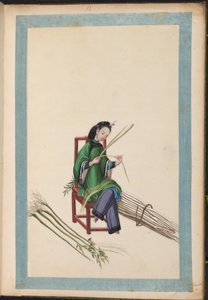The Story of Ramie From Seed to Finished Garment Book 1
- Circa 1820 – 1870

Rights
Download all 15 images
PDFZIPof full-sized JPGsDownload selected image
Small JPG1200 x 1722px — 332 KBLarge JPG2880 x 4133px — 2.1 MBFull-sized JPG6016 x 8633px — 9.1 MBOriginal fileTIFF — 6016 x 8633px — 149 MBVolume one of five brocade-bound sets of 60 Chinese watercolor paintings. The watercolors show, in chronological order, the process of producing Ramie cloth, a silk-like fabric, in China during the 1820s. The collection is accompanied by a transcription of hand-written text, describing the steps in Ramie cloth production. These works are part of a long lineage of works by Chinese artists that depict the various processes in the production of materials from China.
These elaborate paintings were made on pith paper supports, a paper-like product made from the pith of a small tree. Pith was a popular painting support of Chinese export paintings as it was a sumptuous but inexpensive form of locally made paper, an alternative to pricier imported European paper. The pith paper paintings are secured onto the album pages with thin, blue silk tapes.
| Property | Value |
|---|---|
| Artist | |
| Provenance |
Collected by Sidney and Mildred Edelstein. |
| Place of creation | |
| Format | |
| Genre | |
| Medium | |
| Extent |
|
| Subject | |
| Rights | Public Domain Mark 1.0 |
| Credit line |
|
Institutional location
| Department | |
|---|---|
| Collection | |
| Exhibited in |
Learn More
Related Items
Cite as
Studio of Sunqua. The Story of Ramie From Seed to Finished Garment Book 1. Pith paper, watercolor (paint), circa 1820–1870. https://digital.sciencehistory.org/works/ko5gpgj.
This citation is automatically generated and may contain errors.



















